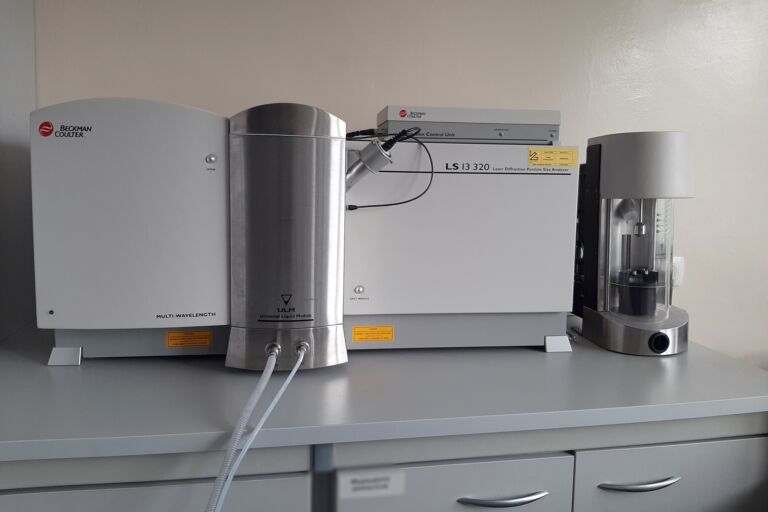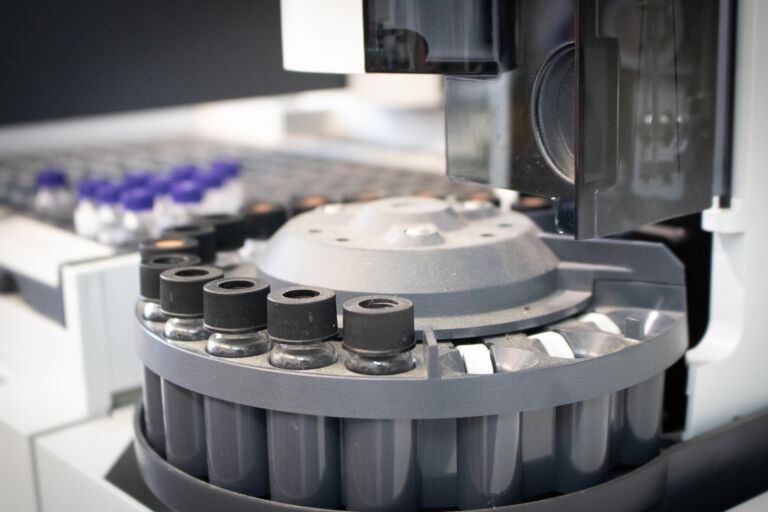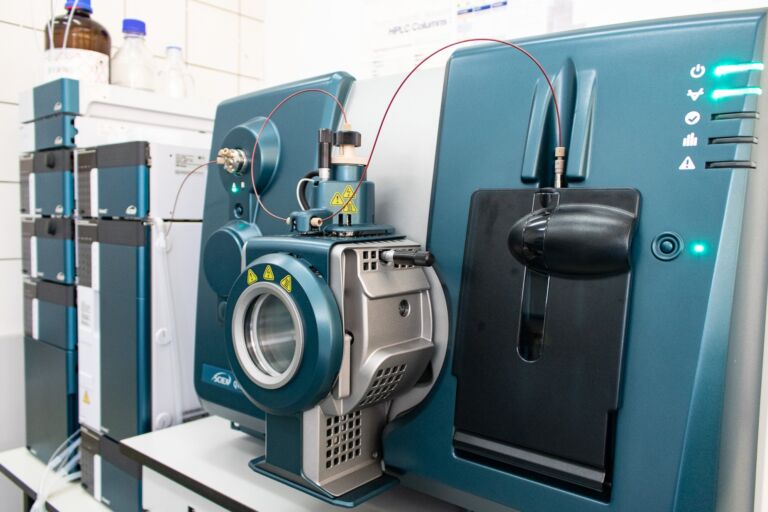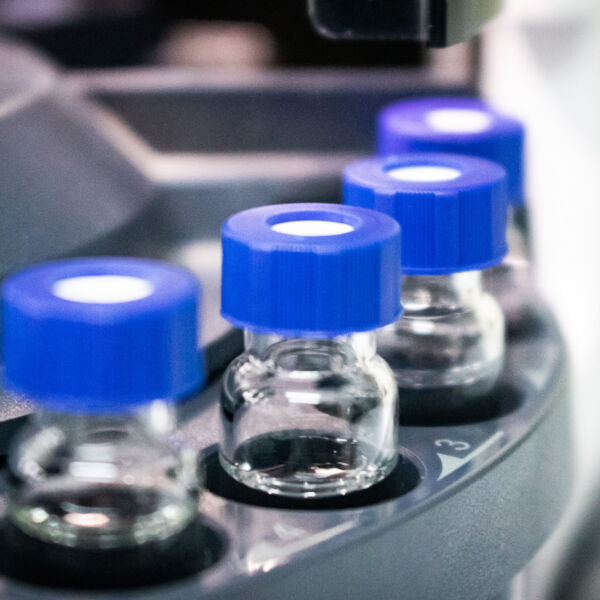Chemical Technology and Biotechnology Research Centre
Chemical and Biological Research Laboratory



Quantitative and qualitative analysis
- Identification tests (MS, IR, UV/Vis at three pH values), (13C NMR, 1H NMR cooperation with ICHO PAN);
- Determination of the molar extinction coefficient according to a procedure based on the method described in EPA No. OPPTS 835.2210, 1998. ‘Direct Photolysis Rate in Water by Sunlight’;
- Development and validation of analytical methods.
- Five-grade testing of organic technical products according to CIPAC and/or in-house methods;
- Confirmation of identity and determination of the content of the main ingredient and impurities in organic products;
- Determination of the content of active substances and relevant impurities in preparations
- Determination of residues of organic substances in different types of matrices (e.g. residues of plant protection products or industrial pollutants in water and plant material) – in-house methods;
- Determination of residual organic solvents by headspace technique.
- Determination of water content using the KF technique.
- Determination of sulphated ash
- Determination of content by titration technique.
The laboratory performs on request
- Research related to the implementation of the Chemical Weapons Convention including expertise and training in the analysis of chemicals related to the Chemical Weapons Convention.
It is a producer of
- Certified reference materials – offering approximately 400 standards.
- Insect pheromones – pheromone dispensers.
- Specialty chemicals – small-scale production.
List of tests performed in the Chemical and Biological Reaserch Laboratory
Analytical studies
| Oznaczanie zawartości substancji czynnych i zanieczyszczeń istotnych technikami GC i HPLC | wg SANCO/ 3030/99 rev.5 |
|---|---|
| Oznaczanie zawartości substancji metodą miareczkowania potencjometrycznego | aparat Titroline |
| Oznaczanie zawartości wolnych fenoli | CIPAC MT 69.1-2 |
Laboratory executes tests of plant protection products, biocides and other substances and formulations.
The scope of research and development activities and services:
- physical and chemical properties studies of substances and formulations (mainly plant protection and biocidal products) for registration purposes and of substances or mixtures for REACH registration purposes.
- the quality of raw and treated waste water – chemical oxygen demand (COD), total organic carbon (TOC), dissolved organic carbon (DOC) and the impact on the environment (biodegradability, toxicity).
- ecotoxicological studies including biodegradability in aqueous environment of substances and polymeric materials.
Physical-chemical testing
| Oznaczanie gęstości cieczy i substancji stałych | CIPAC MT 3 EC A.3 |
|---|---|
| Oznaczanie pH | CIPAC MT 75.3 |
| Oznaczanie kwasowości/ zasadowości | CIPAC MT 191 |
| Oznaczanie lepkości kinematycznej i obliczanie lepkości dynamicznej | OECD 114 |
| Oznaczanie lepkości pozornej metodą Brookfielda | OECD 114 |
| Przeprowadzenie składowania substancji chemicznych i preparatów chemicznych w kontrolowanej temperaturze 20±2℃ | GIFAP No. 17 |
| Przeprowadzenie przyśpieszonego starzenia. | CIPAC MT 46.4. |
| Składowanie substancji chemicznych i preparatów w niskiej temperaturze oraz ocena ich trwałości fizycznej | CIPAC MT 39.3 |
| Oznaczanie trwałości rozcieńczenia środków ochrony roślin tworzących z wodą roztwory | CIPAC MT 41.1 |
| Oznaczanie wylewności płynnych | CIPAC MT 148.1; 148 |
| Oznaczanie zwilżalności substancji stałych | CIPAC MT 53.3 |
| Metody oznaczania trwałości zawiesin wodnych | CIPAC MT 184.1 |
| Oznaczanie trwałości emulsji i suspo-emulsji wodnych | CIPAC MT 36.3; 180 |
| Oznaczanie pienienia | CIPAC MT 47.3 |
| Oznaczanie gęstości nasypowej luźnej i utrzęsionej | CIPAC MT 186 |
| Oznaczanie wielkości ziarna materiałów ziarnistych metodą na sucho | CPAC MT 170 |
| Oznaczanie wielkości ziarna metodą na mokro | CPAC MT 185 |
| Oznaczanie rozpuszczalności opakowań w wodzie | CPAC MT 176; 18 |
| Badanie opakowania | Crop Life Inernational. Technical Monograph No 17 |
| Badanie skuteczności mycia opakowania | Efficacy Guideline 305 |
| Ocena wyglądu badanej próbki | OPPTS od 830.6302 do 04 |
| Oznaczanie rozkładu wielkości cząstek | OECD 110, CIPAC MT 187 |
| Oznaczanie samorzutności dyspergowania stężonych zawiesin i granulatów rozpraszanych w wodzie | CIPAC MT 174; 160 |
| Oznaczanie zawartości pyłu w produktach granulowanych | CIPAC MT 171.1 |
| Badania zaprawy nasiennej pod kątem jej równomiernego rozmieszczenia na nasionach | CIPAC MT 175 |
| Oznaczanie napięcia powierzchniowego roztworów wodnych | EC A. 5 |
| Oznaczanie rozpuszczalności substancji chemicznych | EC A. 6 |
| Oznaczanie współczynnika podziału 1-oktanol/woda: metoda wytrząsania w kolbie | OECD 107 |
| Oznaczanie temperatury krzepnięcia | EC A.1 |
| Oznaczanie temperatury topnienia substancji chemicznych z zastosowaniem rurki kapilarnej w bloku metalowym | EC A.1 |
| Oznaczanie temperatury wrzenia substancji chemicznych z zastosowaniem rurki kapilarnej w bloku metalowym | EC A.2 |
| Oznaczanie węgla organicznego | Analizator węgla org. Shimadzu |
Determination of the susceptibility of chemicals to decomposition
| Badanie przesiewowe wysokiej podatności na biodegradację substancji w tlenowym środowisku wodnym metodą respirometrii manometrycznej | OECD 301 |
|---|---|
| Badanie przesiewowe wysokiej podatności na biodegradację substancji w tlenowym środowisku wodnym metodą zamkniętego naczynia | OECD 301 |
We conduct:
- Biological studies of herbicidal, fungicidal, bactericidal, insecticidal, acaricidal, plant growth regulating and phytotoxic activity. Assessment of the suitability of adjuvants or co-formulants for the formulation of PPPs. We perform quality tests of commercially available preparations. We determine the resistance of technical materials to microorganisms in operating and storage conditions (painting materials – paints, varnishes, plastics, fabrics).
- Services in the field of assessing the effectiveness of biocidal products for registration purposes in the EU based on methods accepted by the President of the Office for Registration of Medicinal Products, Medical Devices and Biocidal Products.. Biocides registration service offering expert guidance on registration requirements (dossier, documents, label, MSDS).
- We develop advanced methods for the synthesis and purification of chemical substances.
Certificates:
- PCBC and IQNet (Certificates of Quality System No. J-753/14/2025 – manufacturing of analytical standards of organic compounds in neat form or in solutions)
- GLP (Statement of GLP Compliance No. 11/2025/GLP in the fields of physicochemical studies, residue studies)
- ISO 9001:2015 – Quality Certification Center of Military University of Technology.
We are entitled to:
- prepare documentation assessments for the approval of active substances, safeners and synergists, for placing plant protection products on the market (authorization by Ministry of Agriculture and Rural Development No. R-1/2012 up of July 4, 2012).
Collaboration opportunities #FutureMadeOrganic

WHAT ARE OUR CORE RESEARCH DOMAINS?
Product innovation • Technology development • Biotechnology • Organic chemistry • Analytical chemistry • Physicochemical analysis • Chemical synthesis • Green chemistry technologies • Safety • Agriculture • Environmental protection
WHY DO YOU NEED US?
We conduct scientific research and development in the field of chemistry and technology of biologically active substances, including plant protection agents, pharmaceuticals, veterinary and hygiene products, biocides, and specialty chemicals for various industries. Our expertise covers analytical research and physicochemical characterization of substances and mixtures, as well as small-scale production for use in agriculture, pharmaceuticals, and the defense sector.
WHERE ARE WE READY TO COLLABORATE?
IMSCA instruments • Cluster 1 • Cluster 5 • Cluster 6 • Widening instruments • EIC / EIT • R&D Projects
Our Expert

Head of Chemical and Biological Research Laboratory
WHO IS OUR GO-TO EXPERT?
Graduate of the Faculty of Biology at Warsaw University of Life Sciences. Holds a PhD degree in biological sciences, with a specialization in biochemistry, awarded by the Scientific Council of the Institute of Biochemistry and Biophysics, PAS in Warsaw.
CONTACT
e-mail:
monika.zareba-koziol@ipo.lukasiewicz.gov.pl
Telephon: +48 22 88 41 220, +48 785 020 303